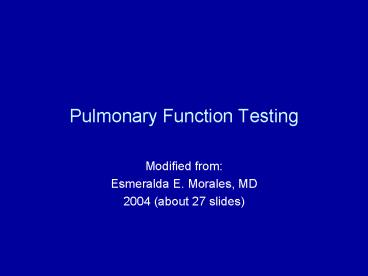Pulmonary Function Testing PowerPoint PPT Presentation
1 / 27
Title: Pulmonary Function Testing
1
Pulmonary Function Testing
- Modified from
- Esmeralda E. Morales, MD
- 2004 (about 27 slides)
2
Objectives
- State the reasons pulmonary function tests (PFTs)
are performed. - Describe the technique and basic interpretation
of spirometry. - State the difference between obstructive and
restrictive lung disease.
3
What are PFTs?
- The term encompasses a wide variety of objective
methods to assess lung function. - Examples include
- Spirometry
- Lung volumes by helium dilution or body
plethysmography - Diffusing capacity
- Bronchial challenge testing
- Exercise tests
4
Why are these tests performed?
- Help diagnose disease
- May help guide management of a disease process
eg, bronchodilators - Can help monitor progression of disease and
effectiveness of treatment - Aid in pre-operative assessment of certain
patients
5
Where would I perform PFTs?
- At home--peak flow meter
- On hospital wards ICUs
- Doctors office
- PFT laboratory in the hospital
- (In order of increasing level of sophistication)
6
Spirometry
- Spirometry is a medical test that measures the
volume of air an individual inhales or exhales as
a function of time. (ATS, 1994)
7
Spirometer Types
- Volume-displacement spirometers
- Flow-sensing spirometers
8
Lung Volumes and Capacities
- 4 volumes 4 capacities
- 2 or more volumes comprise a capacity
9
Lung Volumes
- Tidal Volume (TV) volume of air inhaled or
exhaled with each breath during quiet breathing
(500 ml) - Inspiratory Reserve Volume (IRV) maximum volume
of air inhaled from the end-inspiratory tidal
position - Expiratory Reserve Volume (ERV) maximum volume
of air that can be exhaled from resting
end-expiratory tidal position
10
Lung Volumes
- Residual Volume (RV)
- Volume of air remaining in lungs after maximium
exhalation - Indirectly measured (FRC-ERV) not by spirometry
11
Lung Capacities
- Total Lung Capacity (TLC) Sum of all volume
compartments or volume of air in lungs after
maximum inspiration ( 6.0 L) - Vital Capacity (VC) TLC minus RV or maximum
volume of air exhaled from maximal inspiratory
level ( 4.8L) - Inspiratory Capacity (IC) Sum of IRV and TV or
the maximum volume of air that can be inhaled
from the end-expiratory tidal position
12
Lung Capacities (cont.)
- Functional Residual Capacity (FRC)
- Sum of RV and ERV or the volume of air in the
lungs at end-expiratory tidal position - Can be measured with multiple-breath
closed-circuit helium dilution (not by
spirometry) - RV 1.2L
13
A spirometer can be used to measure
- FVC and its derivatives (such as FEV1, FEF
25-75) - Peak expiratory flow rate
- IC, IRV, and ERV
- Pre and post bronchodilator studies
14
Forced Expiratory Vital Capacity
- The volume exhaled after a subject inhales
maximally then exhales as fast and hard as
possible.
15
Normal values depend on
- Height
- Age
- Gender
- Ethnicity
16
Measurements Obtained from the FVC Curve
- FEV1---the volume exhaled during the first second
of the FVC maneuver - FEF 25-75---the mean expiratory flow during the
middle half of the FVC maneuver reflects flow
through the small (lt2 mm in diameter) airways - FEV1/FVC---the ratio of FEV1 to FVC X 100
(expressed as a percent) an important value
because a reduction of this ratio from expected
values is specific for obstructive rather than
restrictive diseases
17
Obstruction vs Restriction
Airway obstruction
Chest wall restriction
Alveolar restriction
18
Spirometry Interpretation Obstructive vs
Restrictive
- Obstructive Disorders
- Characterized by low FEV1/VC
- Examples
- Cystic Fibrosis
- Bronchitis
- Asthma
- Bronchiectasis
- Emphysema
- C-babe
- Restrictive Disorders
- Characterized by low VC reduced lung volumes
- Examples
- Interstitial Fibrosis
- Scoliosis
- Obesity
19
Spirometry Interpretation Obstructive vs
Restrictive
- Obstructive Disorders
- FEV1 ?
- FEV1/FVC ?
- TLC nl or ?
- Restrictive Disorders
- FVC ?
- FEV1/FVC nl to ?
- TLC ?
20
Spirometry Interpretation What do the numbers
mean?
- FVC
- Interpretation of predicted
- 80-120 Normal
- 70-79 Mild reduction
- 50-69 Moderate reduction
- lt50 Severe reduction
- FEV1
- Interpretation of predicted
- gt75 Normal
- 60-75 Mild obstruction
- 50-59 Moderate obstruction
- lt49 Severe obstruction
21
Spirometry Interpretation
- FEV1/FVC
- Interpretation of absolute value
- 80 or higher Normal
- 79 or lower Obstruction
22
What about lung volumes and obstructive and
restrictive disease?
(From Ruppel, 2003)
23
Helium Dilution Lung Volume
6.0 L
Unknown volume
0 He
5 He
24
Spirometry Pre and Post Bronchodilator
- Measure FEV1
- Administer a bronchodilator.
- Measure FEV1 again a minimum of 15 minutes later
- Calculate percent change
- Reversibility indicated by 15 or greater change.
25
Case 1
26
Case 2
27
The wind God (one of the gods of RC)

